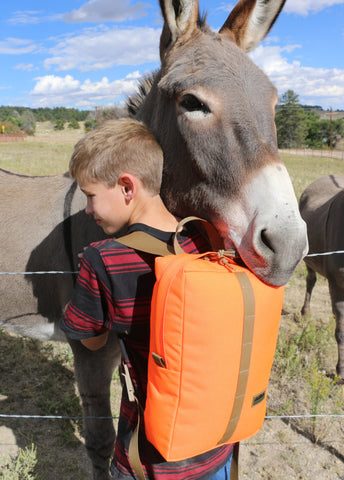My hunting buddy and I were packing up. We were about to head back to the trailhead after a week in the backcountry. I was loading and weighing the panniers while John was saddling the pack burros when a couple of out-of-state, neophyte bow hunters who were camped up the valley walked into camp. They looked concerned. They began to explain when they returned from their morning hunt they discovered that cattle had wandered into camp. The alfalfa pellets that were left on the ground had been eaten. It was all they had for their horse. Plus, the cattle had made a big mess in their camp. But that wasn't the worst of it...the horse was gone!
They had obviously made a few mistakes. Most noteworthy was the knot they had tied the horse to the tree with. The best we could make out by their description was the knot they used was a single half hitch. Not good. We figured the horse was probably well on its way back down the 8 mile trail to the parking lot. When they rented the horse they signed a contract stating that if anything happened to the horse they would owe $5,000. They were very worried that they might have to pay for a horse they did not possess. From the looks of the horse, it wasn't worth half that much. We recommended they get moving.
So, how does one keep from losing their pack animals when in camp? There are a number of ways to secure your pack string. A very common method is setting up a highline.
Highline Setup
A highline is a tight line strung above the animals' heads between to live trees. Tied to the highline are leads that must be the right length so your pack animals won't get into trouble. Lots of folks use this method but it takes practice setting and training to execute a proper highline setup that will keep your equine tied safely.
Picket Your Pack Stock
Another method is to picket your pack stock. I don't picket all my animals; I choose the animals that have demonstrated they don't have issues when tied to a picket. Animals that pull too much or struggle on the picket will get themselves into trouble by either chafing their pastern or pulling a muscle in their leg or shoulder. I have a couple of jennets that do well on a picket. I can tie them and the others will feed nearby without wandering too far. I also tie a Swedish bell around one of the animals that aren't picketed. If I am in my tent it is reassuring to hear the bell and know they are close.
Secure a Pack String with a Portable Electric Fence
My standard method of keeping my pack string in camp is by erecting a portable electric fence. I put the fence up at home first and get them used to it before I take them into the backcountry. The fence is 80 feet square but I don't put it up all at once. I start off small so they can't eat too much too soon and founder or colic. Each day I expand it by about 10-15 feet. Depending on forage I may have to move the corral to a new spot after a few days.
Choose a method that gives you confidence that your equines won't run off. It's hard to enjoy yourself if you don't have peace of mind your animals are safe in camp when you aren't there or at night. It would be no fun to be left high and dry in the backcountry. Different situations may call for different methods so my advice is to learn and practice all of these techniques, including proper highline setup, so that you have options.
The horse did exactly what we told the amateur hunters it would, it headed back towards the parking lot. Luckily, some hikers along the trail caught it and started back up the trail so they didn't have to walk the entire 8 miles. John and I have them a few pointers for keeping a horse in camp. I had a small pocket sized knot guide that I gave them and I pointed out the bowline knot. Experience is sometimes the best teacher.



